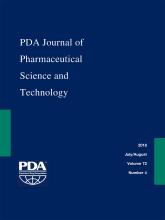Abstract
In order to further clarify if and how much ozone is generated during high-voltage leak detection and to identify measures to reduce the impact of ozone generation on product quality, a highly sensitive analytical system was employed to investigate the generation of ozone at different operational conditions of high-voltage leak detection integrity testing. The analytical system is based on oxidation of Iodide ions in solution and identification of the Iodine formed by N, N-Diethyl-p-phenylendiamine (DPD) according to DIN 38403. Sensitivity of the system was found suitable to detect ozone levels as low as 0.025 ppm (mg/L). High-voltage leak detection process parameters—inspection speed, high voltage, filling level of the ampoule, and exposure time to the ampoule to high voltage—were varied between maximum and minimum values applicable in integrity testing of different ampoule sizes. For variation of exposure time, ampoules were repetitively tested by the leak testing machine to achieve a maximum exposure time of the ampoule up to 24 s (exposure time during production ≤2.4 s). No ozone was detected during the study under all inspection conditions. Even repeated exposure of the ampoules to high-voltage leak detection did not result in generation of measurable ozone levels. It has to be concluded that high voltage leak detection is not prone to causing oxidation of the drug products.
LAY ABSTRACT: For drug products in ampoules, 100% integrity testing is requested both by European and US regulations. Detection of integrity defects like small holes or cracks in the ampoule can be performed by numerous methods. Due to automation requirements, only three methods have been used during routine production—vacuum decay, head space infrared spectroscopy, and high-voltage leak detection. High-voltage leak detection is the most common method used in the pharmaceutical industry for 100% integrity testing of ampoules, but resent publications showed considerable oxidation of an air-sensitive active pharmaceutical ingredient during the integrity testing process. It was assumed that ozone generated in the inside of the vial due to exposure of the product to the high voltage during the testing process may be responsible for this result. As ozone is a very aggressive and non-selective oxidant, this result posed a serious thread not only to this product but also to the quality of many other products subjected to integrity testing by high-voltage leak detection.
- © PDA, Inc. 2018
PDA members receive access to all articles published in the current year and previous volume year. Institutional subscribers received access to all content. Log in below to receive access to this article if you are either of these.
If you are neither or you are a PDA member trying to access an article outside of your membership license, then you must purchase access to this article (below). If you do not have a username or password for JPST, you will be required to create an account prior to purchasing.
Full issue PDFs are for PDA members only.
Note to pda.org users
The PDA and PDA bookstore websites (www.pda.org and www.pda.org/bookstore) are separate websites from the PDA JPST website. When you first join PDA, your initial UserID and Password are sent to HighWirePress to create your PDA JPST account. Subsequent UserrID and Password changes required at the PDA websites will not pass on to PDA JPST and vice versa. If you forget your PDA JPST UserID and/or Password, you can request help to retrieve UserID and reset Password below.






